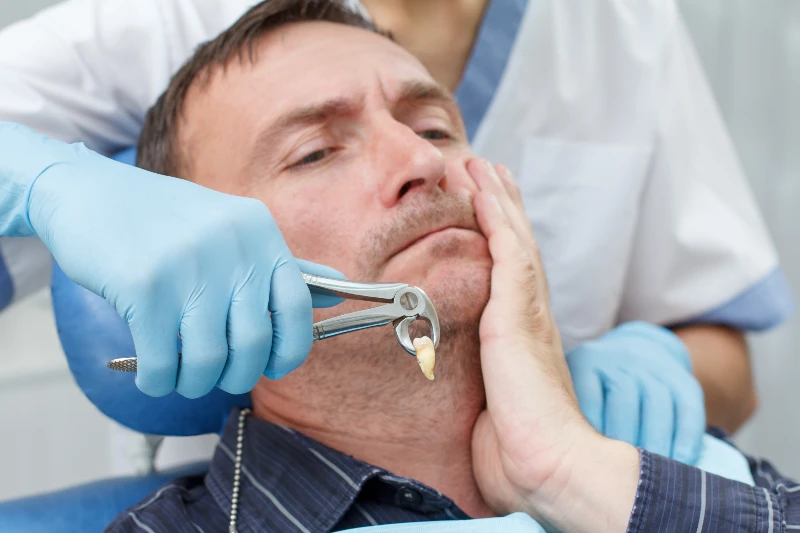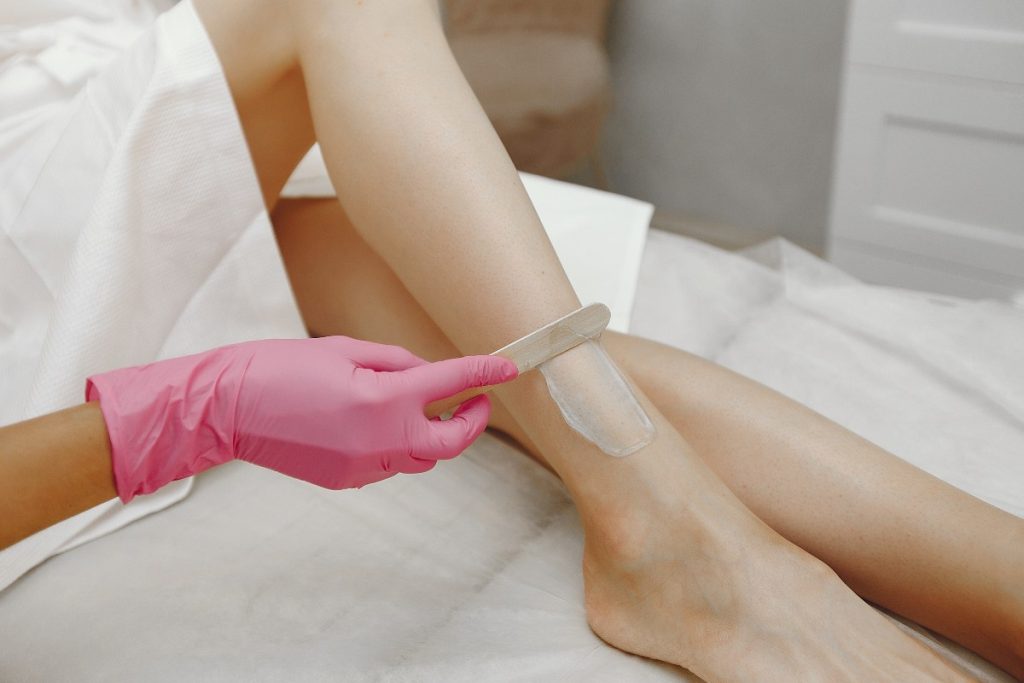As you may know, smoking after tooth extraction can increase the chance of getting dry socket, a complication that not only disrupts your comfort but also delays the healing process.
However, if you find yourself in a situation where you cannot control the desire to smoke, first you need to understand the risks involved and learn about how to do it as safely as possible after tooth extraction.
Understand Why Tooth Extraction May Cause Dry Socket
A tooth extraction leaves behind an open wound in the mouth, an area that is supposed to heal over time with proper care.
This healing process begins with the formation of a blood clot in the socket where the tooth once was.
That clot serves a very important purpose: it stops the bleeding and acts as a foundational layer for new tissue to grow. More importantly, it protects the exposed bone and nerves underneath.
When this clot is disturbed or fails to form, you’re faced with a dry socket – a condition where the nerves and bone are exposed to air, food, bacteria, and other irritants. This can result in increased pain, a slowed healing process, and potential infection.
What Happens If You Smoke After a Tooth Extraction
Smoking is a primary risk factor for developing a dry socket because it not only introduces toxins to the wound area but also creates a vacuum-like suction in the mouth when inhaling, which can dislodge the blood clot vital for your recovery.
Without this clot, healing slows significantly.
Moreover, the chemicals in tobacco smoke—such as nicotine, tar, and carbon monoxide—pose further threats. Nicotine restricts blood flow, tar introduces carcinogens and irritants to the wound, and carbon monoxide reduces oxygen levels in your blood.
All these factors combined create an inhospitable environment for healing and increase your risk of infection and painful complications.
When Can You Smoke After Tooth Extraction?
If you just had a tooth pulled, your dentist will probably tell you to stay away from smoking for at least 48 to 72 hours. That’s about two to three days. This break gives the spot where your tooth was time to start healing.
The blood clot that should be there needs a chance to get strong so it can protect the bone and nerves beneath.
But let’s say you really, really want to smoke. It’s still best to wait as long as you can. When you can’t wait any longer, try not to smoke the way you usually do. Instead of taking big, deep inhales, keep it light. Think of sipping air, not gulping it. That helps keep the blood clot in place.
It’s not just about waiting and changing how you smoke, though. Help yourself out by using different ways to satisfy your nicotine needs.
Try stuff that doesn’t involve smoking. You could use patches that stick to your skin or chew nicotine gum. Also, make sure you keep cleaning your mouth but be gentle around the spot where your tooth was.
When you do start smoking again, go easy and remember every puff could bother that healing spot. If you stay careful and clean, and maybe use other nicotine options, you up the chances that your mouth will heal without any trouble.
Your overall goal is to make sure the area where your tooth was stays healthy, so the new tissue can grow. Keeping away from smoking helps a lot, but if you must smoke, doing it the right way is key.
You Need to Know The Impact of Smoking on Healing Before Smoking
If understanding the risky timeline isn’t enough to curb your smoking habit post-extraction, grasp the consequences smoking has on the body’s healing process.
Reduced Blood Flow
As said before, nicotine constricts your blood vessels. This significantly reduces blood flow to your mouth’s tissues, starving them of the oxygen and nutrients needed to promote healthy tissue regeneration and healing.
Delayed Immune Response
Smoking can delay your body’s immune response, weakening your defenses against infection at the very moment when your open wound needs protecting. A hampered immune response results in a sluggish healing process and opens the door to potential complications like dry socket.
Increased Infection Risk
The act of smoking introduces bacteria and contaminants from your mouth and the surrounding air straight to the vulnerable extraction site. These unwelcome guests can compromise the wound, paving the way for infections that not just prolong healing but can also amplify your pain and discomfort.
Choose the Right Smoking Method
If you still choose to proceed with smoking post-extraction, selecting a smoking method that’s least likely to disturb the healing process is essential.
However, keep in mind that no smoking method is truly safe after a tooth extraction. The ideal course of action is to refrain from all forms of smoking to ensure optimal healing.
If you must smoke, do it with extreme caution and awareness of the potential consequences.
Pipes and Cigars
It may be tempting to think pipes or cigars offer a safer alternative as they require less suction and, therefore less likely to dry socket.
However, just like cigarettes, smoking pipes and cigars also involves a sucking action which can create negative pressure in the mouth. This pressure can dislodge the all-important blood clot at the extraction site.
In addition to the suction risk, the smoke from pipes and cigars is just as full of toxins as cigarette smoke. These toxins can irritate the extraction site, contributing to inflammation that impedes the healing process, and potentially lead to infection and dry socket.
Vaping
Vaping may offer a slightly reduced risk of developing dry socket compared to traditional smoking methods, but it’s far from a safe choice.
The reason for this slightly lower risk is that the action of vaping often involves less intense sucking than smoking a traditional cigarette, pipe, or cigar, thereby potentially exerting less negative pressure on the surgical site.
However, this does not mean vaping is completely without risk. Even the gentlest inhale on a vape pen can create some level of suction that might disturb the blood clot at the extraction site.
Moreover, vaping liquids contain various chemicals and flavorings, some of which might irritate the wound or have unknown effects on the healing tissue. The vapor produced can also dry out the mouth, and a dry mouth is not conducive to healing as it may reduce the protective saliva layer that helps with the natural process of wound recovery.
How Vaping Might Reduce the Risk If You Have to Smoke
If you find yourself absolutely needing to smoke and vape is the chosen delivery method, here are steps to consider reducing the risk of dislodging the blood clot:
- Mouth Position: Try to avoid direct suction with your mouth. Instead, draw the vapor in more passively – think of slowly drawing in air rather than tightly clamping down and inhaling sharply.
- Inhalation Technique: Inhale very gently. Minimize the force to prevent any negative pressure that could affect the wound site.
- Frequency and Duration: Limit the number of puffs you take and the duration of each vaping session. The less exposure yourextraction site has to suction and toxins, the better.
- Device Settings: Use a vaping device that allows you to control the output and set it to the lowest possible setting. This reduces the amount of vapor produced per puff, thereby decreasing the chance of suction.
- Avoid Direct Airflow: When you inhale, ensure that the airflow from the device is directed away from the extraction site. This can be managed by positioning the device differently or adjusting the angle at which you vape.
Remember, even with these precautions, no method of smoking or vaping can be considered entirely safe after a tooth extraction. The best way to prevent complications like dry socket is to avoid all types of smoking and vaping completely until the area has healed sufficiently.
Be sure to discuss your intention to return to smoking or vaping with your dentist, so they can provide you with tailored advice and additional precautions specific to your situation and dental health.
Importance of Gauze and Rinsing
Minimizing the negative impact of smoking on healing can be somewhat addressed through the use of gauze and proper rinsing techniques. These methods can offer some protection to the extraction site while you smoke.
Using Gauze
The gauze can help to shield the clot, which acts as a barrier, absorbing some of the chemicals from the smoke that might otherwise impinge on the wound. Also, it reduces the direct suction force on the clot itself.
When you decide to smoke, gently place the gauze over the extraction site, ensuring it’s snug but not so tight that it causes discomfort.
Then light the cigarette, pipe, or vaping device and draw smoke into your mouth with minimal force, think gentle sipping rather than a hard draw. Once done, carefully remove the gauze and discard it.
Rinsing Your Mouth
Rinsing should be done not just after smoking but also can be considered before smoking to ensure the mouth starts clean.
To rinse, take a mouthful of warm saline solution (created by mixing a teaspoon of salt into a cup of warm water) and gently swish it around your mouth, being careful not to create any forceful swishing movements that might disrupt the clot.
After a minute, lean over the sink and let the solution dribble out of your mouth. It’s recommended to do this gently to avoid the motions that can lead to dislodging the clot.
Maintain Oral Hygiene During Recovery
Good oral hygiene is essential for preventing infection and encouraging healing following tooth extraction. However, your regular routine will need some adjustments.
Gentle Brushing
Brushing your teeth is still important, but you must do it gently to avoid disturbing the extraction site. Use a soft-bristled toothbrush and be gentle around the site of extraction. Avoid brushing the clot directly; instead, carefully clean the areas around it.
Avoid Mouthwash
Commercial mouthwashes often contain alcohol and other ingredients that can irritate the wound. For the first 24 hours, most dentists recommend not using mouthwash at all.
After that, use either the warm saline solution mentioned earlier or a gentle, alcohol-free mouthwash as advised by your dentist. This type of mouthwash can help keep the mouth clean without the harshness of regular mouthwashes, which can sometimes delay healing.
Stay Hydrated
Keeping well-hydrated is key to a speedy recovery. Water helps to keep your mouth moist and supports the body’s natural healing processes. It also aids in flushing out bacteria and food particles that could otherwise nestle into the extraction site, potentially causing infection.
Alternatives to Smoking During Recovery
For smokers undergoing tooth extraction, breaking the habit even temporarily can be tough. During the healing process, instead of smoking, consider alternatives that can fulfill your nicotine cravings without impacting your oral health.
Nicotine patches, gum, or lozenges can provide the nicotine your body is craving without the need to inhale anything into your mouth. Not only can these alternatives help you manage withdrawal symptoms, but they also avoid the issue of suction and contaminants that come from smoking.
Furthermore, other ways to distract yourself from the urge to smoke include engaging in activities that keep your hands and mind busy. Picking up a hobby, exercising, or spending time with supportive friends and family can shift your focus away from smoking.
It’s also an excellent opportunity to explore methods that can help you quit smoking in the long term, benefiting not only your oral health but your overall well-being.
Signs of Dry Socket and When to Seek Help
After tooth extraction, especially with smoking involved, it’s key to stay alert for signs of trouble. Even with all the right precautions, the risk of developing a dry socket remains higher for smokers. This painful condition is a clear signal that something’s not right with the healing process.
The most obvious sign is a throbbing pain in the gum where your tooth used to be. This pain might also spread to your ear, eye, temple, or neck on the same side of your face. Another red flag is seeing an empty-looking socket or bone where your tooth was, without the blood clot that should be there.
Other symptoms to watch out for include:
- A bad taste in your mouth that doesn’t go away even after rinsing.
- Persistent bad breath despite good oral hygiene.
- An absence of expected relief from pain medications.
If you’re experiencing any of these symptoms after an extraction, get on the phone to your dentist. They’re the ones who can give you the right care, which might include cleaning out the socket, dressing the area, and possibly prescribing medications to manage pain and preventinfection.
You might be tempted to wait it out, but with dry socket, that’s not a good idea. Getting professional help as soon as you notice symptoms can head off a lot of pain and help the area start healing the way it’s supposed to.
Conclusion
By taking the necessary precautions and being mindful of the risks, you may increase the chance of preserving the health of your mouth after an extraction, even if you choose to smoke.
But you need to know that the best way to avoid dry socket and other complications is to follow your dentist’s advice on oral care and to delay smoking for as long as possible after the procedure.
Your recovery may depend on it, and your body will thank you for the extra care and attention you provide during this critical healing phase.





